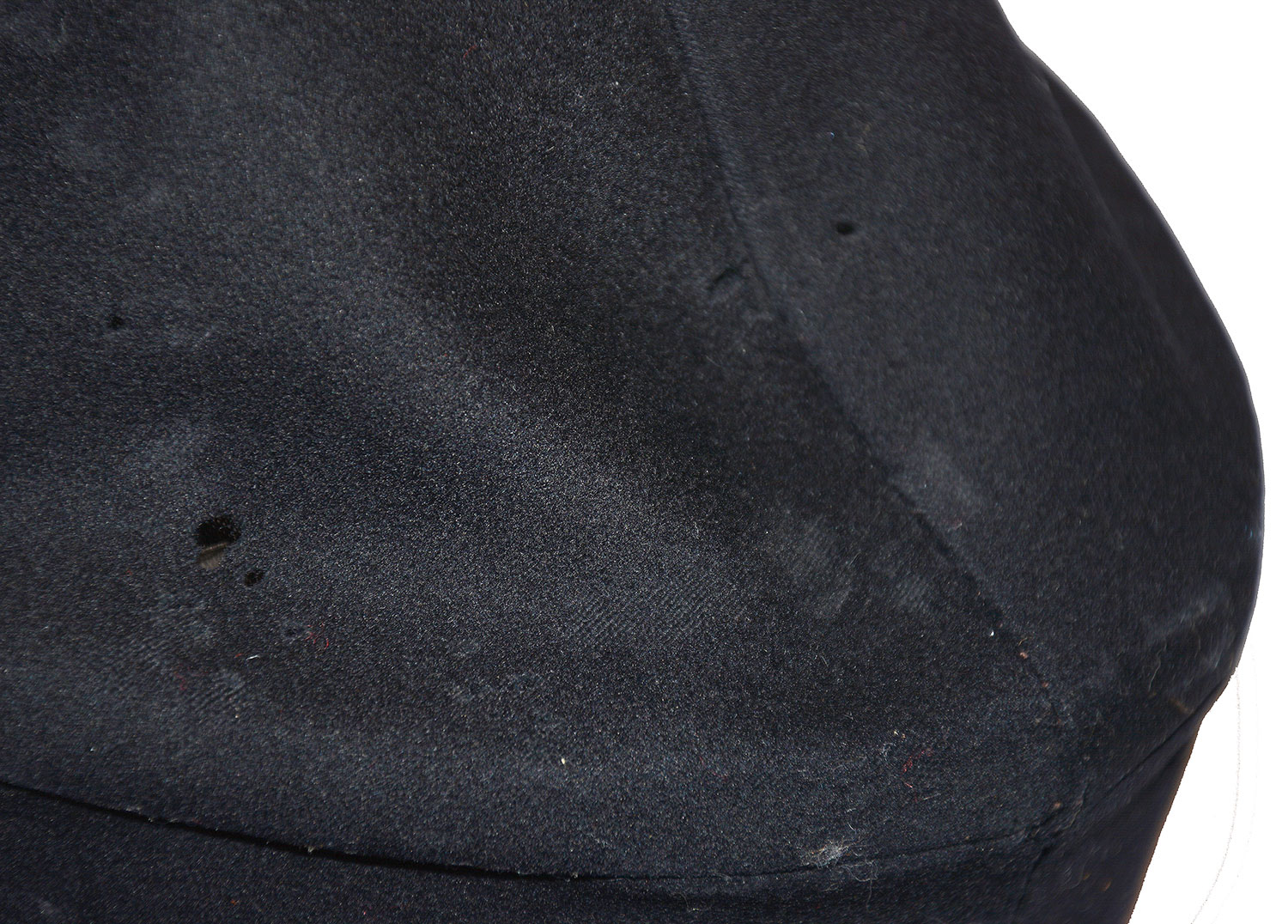site search
online catalog
CIVIL WAR CAVALRY STAFF OFFICER’S KEPI

Hover to zoom

















$3,750.00 SOLD
Quantity Available: None
Item Code: 1179-408
This medium-height kepi has cavalry officer Eagle-C buttons securing the chinstrap and a very nice M1851/58 embroidered bullion U.S. staff wreath insignia on the front, indicating the officer was serving on staff duty at the regimental or higher level, although use of such insignia also by regimental field officers is not unknown. The cap is one of several styles purchased by officers, who had to supply their own uniforms, and is a classic kepi in form, having an inset top, rising to about 4 ½ inches when fully extended, and a band about 1 ½ inches tall, as defined by a seam, running around the base of the cap.
The body is dark blue wool, in very good condition, with good color and just scattered pencil-point moth nips. These are on the lower front of the top, a couple just above the staff wreath, a few below it on the wearer’s left just above the chinstrap, and a few on the back and the band around the base. None of these need repair, the cap is structurally fine, and none are particularly noticeable against the cap’s dark lining. The visor is firmly attached and has a bound edge. The chinstrap is narrow and fitted with a fixed friction buckle on one half of the strap and a standing loop on the other. The sweatband is complete and firmly in place. It shows just minor wear along the lower edge and has a slightly purple cast indicating it is likely Morocco. The cap is lined in black silk, now oxidized slightly toward brown. The lining has some small tears and runs, mostly on the sides and back, but does not seem to have any missing pieces. The lining on the underside of the top is fully intact. The cap was made without any padding or batting between the lining and exterior fabric.
The U.S. staff wreath insignia is held by its original stitching and is in excellent condition with considerable luster remaining on the gold bullion embroidered laurel wreath and the silver bullion embroidered “U.S.” in Old English on a dark blue ground. Adopted in 1851 and specified again in 1858 and 1861 for general officers and staff officers, this insignia was mounted on the cap without the jaceron wire border. That border is usually seen on officer hat insignia, at least of other service branches, but may have been a conscious omission with a U.S. Staff Wreath, as either a distracting or redundant border. We note that many examples of this insignia on extant headgear and in period photos seem to omit it. See O’Donnell and Campbell, Headgear Insignia, and Jim Frasca’s still relevant 1980 North-South Trader articles. Some of these may have lost the wire border from use, but enough are without it that we think there was some conscious choice here.
This is a very good looking, regulation cap that would have been worn by a cavalry regimental adjutant or other member of the staff, a field-grade regimental officer, or an officer serving as aide-de-camp or some other function on a brigade, division, or even higher level staff. We often mistakenly think of staff officers as desk bound, but they were often on the front lines, carrying messages, giving orders and even directing troops under fire. More than one such officer recalled the harrowing sound of bullets whizzing by as he performed his duty without the luxury of taking cover or satisfaction of returning the compliment. [sr] [ph:L]
~~~~~~~~~~~~~~~~~~~~~~~~~~~~~~~~~~~
THIS ITEM, AS WITH ALL OTHER ITEMS AVAILABLE ON OUR WEB SITE,
MAY BE PURCHASED THROUGH OUR LAYAWAY PROGRAM.
CLICK HERE FOR OUR POLICIES AND TERMS.
THANK YOU!
Inquire About CIVIL WAR CAVALRY STAFF OFFICER’S KEPI
Most Popular
Historical Firearms Stolen From The National Civil War Museum In Harrisburg, Pa »
Theft From Gravesite Of Gen. John Reynolds »
Selection Of Unframed Prints By Don Troiani »
Fine Condition Brass Infantry Bugle Insignia »
British Imported, Confederate Used Bayonet »
Scarce New Model 1865 Sharps Still In Percussion Near Factory New »
featured item
RARE CIVIL WAR “SURGEON’S COMPANION” OR “U.S. ARMY MEDICINE CASE FOR FIELD SERVICE” WITH MASS VOLUNTEER MILITIA MARKINGS, LABEL, AND TINS
This scarce piece of military surgeon’s field gear is in very good condition with both the shoulder and waist belts with buckles full length, in place, and intact, as is the narrower strap buckling over the top to keep the lid closed. This follows… (766-2008). Learn More »


